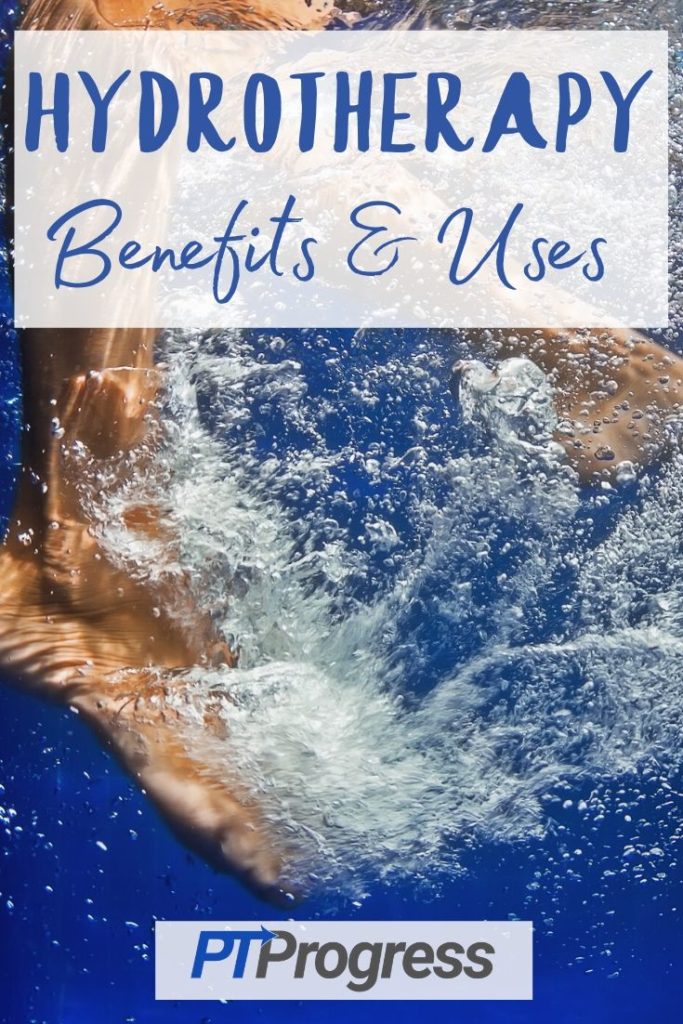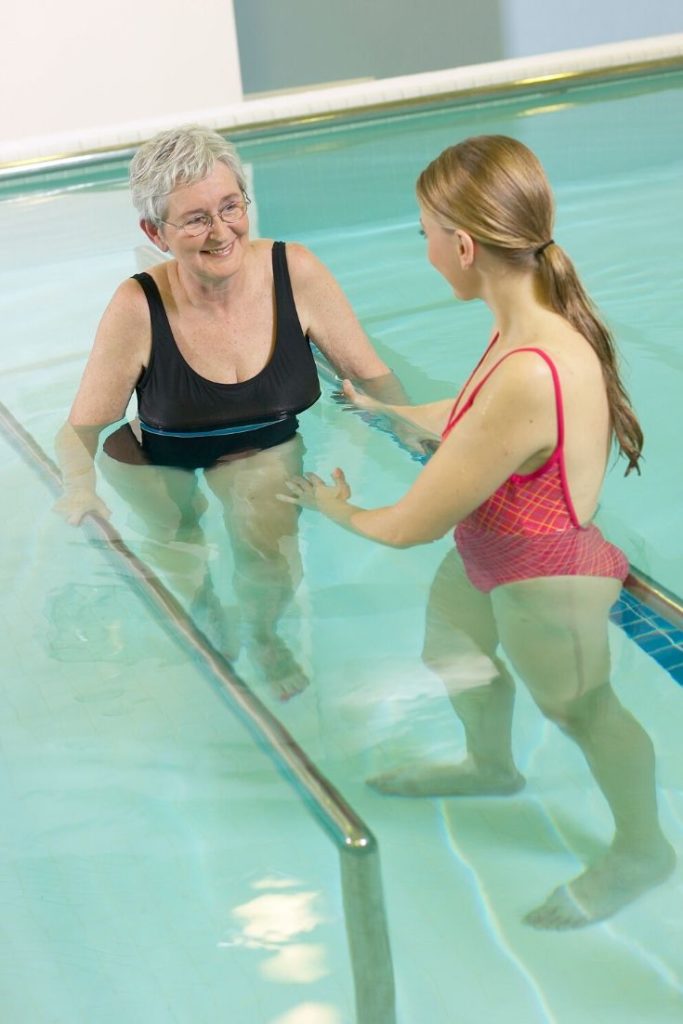
Dating back to the ancient Egyptians, hydrotherapy – or perhaps more accurately, the use of water for therapeutic purposes – is one of the oldest forms of “medicine”. But what comes to mind when I mention the term hydrotherapy? Can you think of one specific form of treatment or do several different things that you can vaguely recall flash before your eyes?
What if I asked you to tell me the difference between hydrotherapy and aquatic therapy? In this article we’ll set you straight on what hydrotherapy is, how it is used, and for what conditions it can be an effective form of treatment.
What is Hydrotherapy?
Broadly defined, hydrotherapy is the use of water, or an aquatic environment, as a modality to take advantage of its inherent properties (ie. buoyancy, hydrostatic pressure, cohesion, temperature, etc) for therapeutic purposes. Although it should be noted that hydrotherapy is not swimming.
To answer the question we often hear in the physical therapy clinic: is hydrotherapy different than aquatic therapy? There is really no difference between hydrotherapy and aquatic therapy; they are terms used interchangeably to describe the same types of treatment. However, under the umbrella of hydrotherapy/aquatic therapy falls a wide variety of different types of treatments.
Types of Hydrotherapy
Whirlpool
For me, whirlpool therapy is what comes to mind first when I think of hydrotherapy/aquatic therapy. This is where a patient and therapist perform exercise and/or specific manual techniques in a warm water pool. The pool is typically set to 91-96℉ (33-36℃).
Contrast Baths
This is the immersion of a limb or body part in hot and cold water in an alternating fashion to speed recovery. This is proposed to work by improving both blood flow and lymphatic drainage through the repeated cycle of vasodilation and vasoconstriction that occurs when submerged in the hot and cold water respectively.
Hydro-massage
Hydromassage is the use of high-pressure water jets, either in a pool or within a waterbed that you lay on, to provide a form of soft-tissue mobilization. Typically this is marketed for relaxation purposes as opposed to true therapeutic reasons.
Ice Baths
The use of cold water immersion or ice baths can help reduce edema, increase blood flow return, and minimize inflammation by accelerating the metabolism of byproducts from tissue breakdown after exercise. This version of hydrotherapy is typically referred to as cryotherapy.
Benefits of Hydrotherapy1
- Alleviate muscle pain
- Decrease muscle spasticity/tone
- Promote relaxation
- Improve ROM
- Strengthening/gait training while manipulating degree of weight bearing
- Stimulate blood flow
- Diminish nociceptive input from thermal and mechanoreceptors
- Decrease edema
No products found.
What is Hydrotherapy Used to Treat?

Since ice baths are discussed in the cryotherapy article cited above, and contrast baths have been shown to primarily be beneficial in the recovery of elite athletes (less applicable to the average person/clinician), we will focus specifically on whirlpool hydrotherapy/aquatic therapy.2
While there are specific methods/schools of thought when it comes to hydrotherapy/aquatic therapy (ie. Watsu, Bad Ragaz, Feldenkrais, Halliwick, etc) we will paint the picture of physical therapy performed in a whirlpool in slightly broader strokes, if you will. So, let’s discuss a few of the conditions most commonly treated with whirlpool hydrotherapy and whether or not it has been found to be effective.
Rheumatoid Arthritis
In a systematic review published in 2013 of studies that examined the effectiveness of hydrotherapy in the treatment of RA, it was found that hydrotherapy was a better treatment for RA compared to no treatment and when compared to other interventions. Most notably, hydrotherapy helped to decrease overall pain, reduce joint tenderness, decrease muscle tension, increase grip strength, and improve overall mood.3
Is hydrotherapy effective for treating rheumatoid arthritis? Absolutely.
Osteoarthritis
When it comes to knee OA, it would seem that hydrotherapy intuitively makes sense as an alternative to standard land-based therapy, as it offers the potential to decrease weight bearing, to capitalize on hydrostatic pressure for edema reduction, and can utilize the warmth to soothe joint pain and improve ROM- but what does the evidence say?
In 65+ year old females who received aquatic therapy, significant improvements in pain, function, strength, and endurance were found when compared to a control group that received education only; no land-based therapy group.4 Likewise, when compared to no intervention at all, a 6 week program of hydrotherapy was found to be far superior.5
Okay, so hydrotherapy “works” if you compare it to doing nothing, but how effective is it when compared to traditional land-based therapy? One randomized controlled trial (RCT) found land-based therapy to be superior to aquatic therapy for strength gains and pain reduction. In fact, no clinical benefit was seen for the aquatic group compared to the control group, let alone the land-based exercise group.6 However, another RCT found that hydrotherapy was superior to land-based therapy for relieving pain from functional mobility when performed through an 18 week exercise program.7 Other studies, such as the RCT conducted in 2003 on one-hundred and five 50+ year olds with hip/knee OA published in the Annals of the Rheumatic Diseases, have found no difference at all between land and aquatic therapy; both being superior to a control group of no treatment.8
Is hydrotherapy effective for treating osteoarthritis? Yes, but it would seem the evidence is rather mixed if compared to typical physical therapy.
Post-Operative Lower Extremity
After an ACL reconstruction, patients who had 9 weeks of hydrotherapy were found to have improved strength, improved ROM, decreased pain, and decreased swelling when compared to land-based therapy.9 These results are far more promising than those reported in a study done 14 years prior, that only found improvements in joint effusion and self-reported function in the hydrotherapy group.10 However, combining hydrotherapy and land-based exercises was found to be superior than either in isolation.11
When a similar approach is taken comparing hydrotherapy vs land-based therapy for total knee replacements, no statistically significant difference was found. In other words, hydrotherapy and land-based therapy were equally effective forms of rehabilitation.12
Is hydrotherapy effective for treating post-operative patients? Yes, but again it may not be superior to typical physical therapy.
Other Uses of Hydrotherapy
While it may not be as immediately relevant to outpatient orthopedic physical therapists, it should be noted that hydrotherapy has also been shown to be an effective form of treatment for non-orthopedic conditions such as Fibromyalgia13,14 and autism15.
Risks and Contraindications of Hydrotherapy
Risks of Hydrotherapy
- Slipping around the pool
- Heat exhaustion
- Drowning
- Skin Irritation/Infection
Contraindications of Hydrotherapy
- Open wounds
- Active infection
- UTI
- Incontinence
- Diabetes
- Fever
- Seizure disorders
- Intolerance to hot/cold temperatures
- Balance trouble/instability: this is an interesting one because water can help to stabilize someone with poor balance, but there must be a therapist or device present to prevent the patient from falling completely, or risk drowning
- CHF/CAD: Can be problematic if exercises are performed at greater depths secondary to the decrease in peripheral BP and increase in BP around the heart. Though it should be noted that for therapeutic purposes, exercises are rarely- if ever- performed submerged at the bottom of a pool or body of water
Summary
When discussing hydrotherapy it can be difficult to avoid going off on tangents of “this technique vs that technique” since hydrotherapy takes so many forms. When considering physical therapy performed in an aquatic/whirlpool setting, it would seem that as long as you are mindful of the risks and contra-indications, hydrotherapy is a safe treatment option. Generally speaking, hydrotherapy seems to be at least equally effective as traditional therapy, and in some cases may be superior.
If you work in a clinic that has a pool for hydrotherapy, it is likely that you’ve become quite adept at identifying those patients who are likely to benefit from it.
If, like me, you don’t have access to a pool it is likely that you rarely, if ever, consider this as a treatment option. Truthfully, I only discuss hydrotherapy/aquatic therapy with patients/MDs if it seems a patient is failing a course of standard land-based PT (and usually only for cases of lower extremity arthritis). Most of us are far more likely to use varying types of cryotherapy and/or contrast baths in outpatient orthopedic settings.
If you’re a patient who is wondering if hydrotherapy may work for you, the answer is a very ambiguous – maybe. The evidence is there to support its use for certain conditions, but this should be discussed with your therapist or doctor first.

This article was written by Dan Murphy DPT, OCS. Dan graduated from Washington University in St. Louis in 2016 and lives just outside of Chicago with his wife and 2 year old son; though he and his wife are expecting a daughter in a few months! He enjoys playing board games and any outdoor activities with friends and family.
References
- Mooventhan A, Nivethitha L. Scientific evidence-based effects of hydrotherapy on various systems of the body. N Am J Med Sci. 2014;6(5):199-209.
- Bieuzen F, Bleakley CM, Costello JT. Contrast water therapy and exercise induced muscle damage: a systematic review and meta-analysis. PLoS ONE. 2013;8(4):e62356.
- Al-qubaeissy KY, Fatoye FA, Goodwin PC, Yohannes AM. The effectiveness of hydrotherapy in the management of rheumatoid arthritis: a systematic review. Musculoskeletal Care. 2013;11(1):3-18.
- Dias JM, Cisneros L, Dias R, et al. Hydrotherapy improves pain and function in older women with knee osteoarthritis: a randomized controlled trial. Braz J Phys Ther. 2017;21(6):449-456.
- Hinman RS, Heywood SE, Day AR. Aquatic physical therapy for hip and knee osteoarthritis: results of a single-blind randomized controlled trial. Phys Ther. 2007;87(1):32-43.
- Lund H, Weile U, Christensen R, et al. A randomized controlled trial of aquatic and land-based exercise in patients with knee osteoarthritis. J Rehabil Med. 2008;40(2):137-44.
- Silva LE, Valim V, Pessanha AP, et al. Hydrotherapy versus conventional land-based exercise for the management of patients with osteoarthritis of the knee: a randomized clinical trial. Phys Ther. 2008;88(1):12-21.
- Foley A, Halbert J, Hewitt T, Crotty M. Does hydrotherapy improve strength and physical function in patients with osteoarthritis–a randomised controlled trial comparing a gym based and a hydrotherapy based strengthening programme. Ann Rheum Dis. 2003;62(12):1162-7.
- Zamarioli A, Pezolato A, Mieli E, Shimano A. The significance of water rehabilitation in patients with anterior cruciate ligament reconstruction. Physiotherapy. 2008 Apr 1;16(2):3-6.
- Tovin BJ – Phys Ther (1994) Comparison of the effects of exercise in water and on land on the rehabilitation of patients with intra-articular anterior cruciate ligament reconstruction.
- Peultier-celli L, Mainard D, Wein F, et al. Comparison of an Innovative Rehabilitation, Combining Reduced Conventional Rehabilitation with Balneotherapy, and a Conventional Rehabilitation after Anterior Cruciate Ligament Reconstruction in Athletes. Front Surg. 2017;4:61.
- Harmer AR, Naylor JM, Crosbie J, Russell T. Land-based versus water-based rehabilitation following total knee replacement: a randomized, single-blind trial. Arthritis Rheum. 2009;61(2):184-91.
- Silva KM, Tucano SJ, Kümpel C, Castro AA, Porto EF. Effect of hydrotherapy on quality of life, functional capacity and sleep quality in patients with fibromyalgia. Rev Bras Reumatol. 2012;52(6):851-7.
- Lima TB, Dias JM, Mazuquin BF, et al. The effectiveness of aquatic physical therapy in the treatment of fibromyalgia: a systematic review with meta-analysis. Clin Rehabil. 2013;27(10):892-908.
- Mortimer R, Privopoulos M, Kumar S. The effectiveness of hydrotherapy in the treatment of social and behavioral aspects of children with autism spectrum disorders: a systematic review. J Multidiscip Healthc. 2014;7:93-104.

